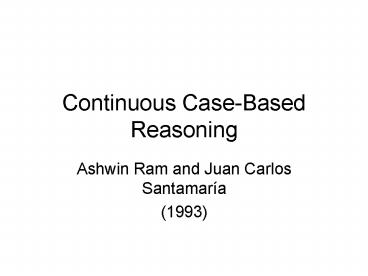Continuous Case-Based Reasoning - PowerPoint PPT Presentation
Title:
Continuous Case-Based Reasoning
Description:
... Real-time The domain is continous ... Experiences are likely to be typical of future experiences Problem domain can be represented quantitatively ... – PowerPoint PPT presentation
Number of Views:59
Avg rating:3.0/5.0
Title: Continuous Case-Based Reasoning
1
Continuous Case-Based Reasoning
- Ashwin Ram and Juan Carlos Santamaría
- (1993)
2
What is it about?
- Investigates the use of CBR in continuous,
real-time problem domains
3
Some characteristics of such domains
- Require continuous representations
- Require continuous performance
- Require continuous adaption and learning
4
Application domain
- Robot navigation (selecting robot behaviours)
- Real-time
- The domain is continous (constant flow of data
from the robots sensors)
5
Schema-based reactive control
- Schema-based navigation is a form of reactive
control that decomposes actions into a set of
multiple concurrent processes called motor
schemas. Each of these active behaviors generates
a velocity vector based upon immediate sensory
data which is combined with the outputs of the
other behaviors. The result is transmitted to the
robot for navigation.
6
(No Transcript)
7
(No Transcript)
8
ACBARR
- A Case-BAsed Reactive Robotic (system)
- A case contains
- Assemblages of behaviors
- Behavior adaptions
9
(No Transcript)
10
(No Transcript)
11
Moving on...
- ACBARR relied on a fixed library of handcoded
into the system - SINS (Self-Improving Navigation System) can learn
new cases through experience
12
SINS
A case in SINS consists of associations between
sensory inputs and schema parameters
13
(No Transcript)
14
(No Transcript)
15
Assumptions
- Environment is
- Causal same actions executed under the same
environmental would result in same/similar
outcomes - Consistent small changes in executed actions -gt
small changes in actions
16
Assumptions
- Experiences are likely to be typical of future
experiences - Problem domain can be represented quantitatively
17
Innovations
- Continuous cases
- Abstract cases
- Virtual cases
- Two types of behavior modification
- Two types of adaption
- On-line real-time response
- Adaptive reactive control
18
Conclusions
- Open issues
- Size and extent of cases
- Cases are not easy interpret































